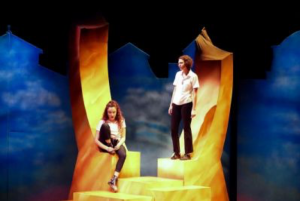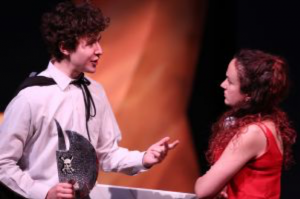By Rachael Coopes. Riverside and Bathurst Memorial Entertainment Centre in association with Australian Theatre for Young People. Riverside Theatres, Parramatta. Nov 22 – 24, 2018.

Bathurst was the first ‘inland city’ established by the white settlers who followed Blaxland, Lawson, Wentworth and their Aboriginal guides over the Blue Mountains in 1813. On the land of the Wiradyuri people, they established a settlement that would become a beacon to the west. But in this process, they ‘highjacked’ and destroyed aboriginal sacred sites and burial grounds.
In The Climbing Tree, Rachael Coopes has documented four years of workshops and research into a play that gathers together what director Stephen Champion describes as “the thematic threads and heart” that tell the “essential stories of Bathurst”. It is a moving history that tells of ancient legends and old tragedies alongside contemporary issues and protests. In the hands of four gifted performers, a multi-talented musician and an empathetic director, it is a story that reveals not only “the essence of Bathurst” but of Australia itself.
They have an essence of Bathurst in them with much broader resonance and we hope to share them widely”. I echo that hope.
The set, the “climbing tree”, designed by Kari Shead, symbolises the place where four high school students escape the many issues that colour their lives – problem parents, exams, racism, discrimination, curfews, drugs, their indignation about the demeaning statue of an aboriginal man kneeling at the feet of an explorer and the use of the sacred mountain, Wahluu, as The Mount Panorama race circuit.
With the sound of the 35 bells of the Carillon punctuating the dialogue, their modern-day problems echo issues of the past – a convict servant’s concern about falling in love with her master’s son; the public flogging of the convict Ralph Entwhistle for skinny dipping in 1839; his subsequent hanging with nine other bushrangers in 1830; and the mistreatment of European migrants.
The stories transition via sound effects and the voice of “authority” operated and performed by Tim Hanson, who influences the changes in pace and atmosphere of the performance. Lighting by Bannon Rees helps shift time, place and prevailing mood.
There is a certain type of energy required to portray teenagers and all four actors find it convincingly. Peppered with the idiom and humour that Coopes has injected into the dialogue and the variation in pace Champion has directed, their appeal to both young and old audience members is electric.

Madelaine Osborn is beautifully believable as the rebellious but bright Rayleen, who, despite carrying the burden of an addicted mother, a young sister and unsympathetic schoolteachers, is lively, cheeky, funny and caring.
Jayla-Shae Davey plays her best friend, but complete opposite, Kylie. Davey portrays the different dimensions in Kylie’s character – her desire or justice and reconciliation, her ambition to lead but lack of belief in herself and the calming effect she usually has on. . . .
Review continued in Stage Whispers magazine.